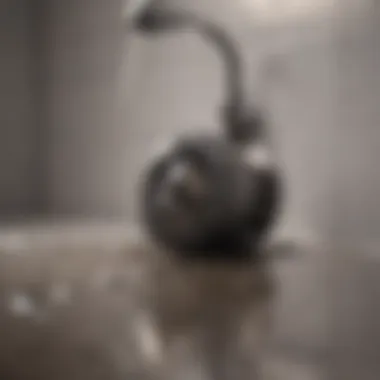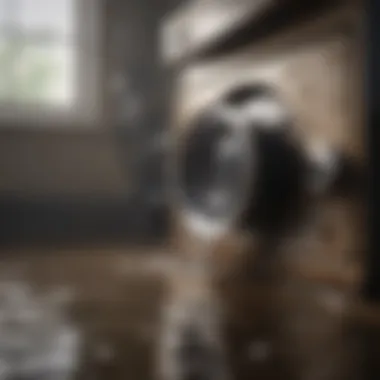Effective Methods for Unclogging Hair from Drains


Intro
Clogged drains often lead to frustration and inconvenience. Understanding how to address these problems can not only save time but also money on plumbing repairs. Homeowners must recognize effective solutions and preventive measures to maintain clean drains and proper plumbing functionality.
Importance of Addressing Hair Clogs
Hair clogs affect many households. They are often seen in showers and sinks, creating slow drainage and unpleasant odors. They can also back up water, leading to more serious plumbing issues if left untreated. It is essential for homeowners to equip themselves with knowledge on how to prevent and manage these clogs before they escalate. By employing effective strategies, one can maintain a seamless drainage system.
Key points that will be discussed in this article include:
- Effective methods for unclogging drains
- Prevention techniques using common household items
- Safety considerations when dealing with plumbing
- Long-term maintenance practices to ensure smooth operation of drainage systems
In the following sections, we will explore various ways to combat hair clogs, addressing both immediate solutions and preventive measures.
Understanding Hair Clogs
Hair clogs in drains are a fundamental issue that many homeowners encounter. Understanding the nature of these clogs is pivotal for effective prevention and resolution. The challenge they present is not merely cosmetic; it often leads to more serious plumbing problems if left unaddressed. This section explores what hair clogs are, their common causes, and when it's necessary to call in professionals for help.
The Nature of Hair Clogs
Hair clogs occur when strands of hair accumulate within the drainage system, creating blockages that impede water flow. These clogs can form gradually over time with regular use of sinks, showers, and bathtubs. Hair itself does not dissolve in water and tends to entwine with soap scum, grease, and other debris. This combination exacerbates the blockage issue.
Understanding the physical properties of hair and how they interact with plumbing systems can be eye-opening. Hair often clings to the insides of pipes, especially if the pipes are older or have become rough due to wear. This adhesion makes it increasingly difficult for water to flow freely, leading to overflowing sinks or slow-draining tubs.
Common Causes of Hair Accumulation
Several factors contribute to hair accumulation in drains. Awareness of these factors can help in developing a plan to minimize clogs:
- Regular grooming habits: Simple activities like brushing or cutting hair can release strands that wash down the drain.
- Shower use: Most people lose some hair during daily showers. Without proper measures in place, this hair can easily accumulate.
- Inadequate drain covers: Homes without drain screens or covers often struggle with hair getting into the plumbing.
- Poor drainage design: Older homes may have less effective drainage systems, leading to more frequent clog issues.
When to Seek Professional Help
While some hair clogs can be resolved with simple home remedies, others may require professional intervention. It’s essential to recognize the signs that indicate a need for expert assistance. You should consider seeking help if:
- Multiple drains are clogged: If multiple fixtures exhibit sluggish draining, this could indicate a broader issue in the plumbing system.
- Persistent backups: If clogs recur regularly despite home remedies, this suggests deeper problems that need addressing.
- Foul odors or unusual noise: If there are strong smells or sounds coming from the drain, this could point towards advanced blockages.
In summary, understanding hair clogs is essential for effective plumbing maintenance. By recognizing their nature, common causes, and when to seek professional help, homeowners can take proactive steps to manage drain issues, thereby enhancing the longevity of their plumbing systems.
Home Remedies for Clogs
Home remedies for unclogging hair from drains provide an accessible, cost-effective solution before resorting to harsher chemical cleaners or professional services. These methods often employ common household items that are kind to both the environment and one's plumbing. One of the primary benefits of using home remedies is their simplicity; they can often be executed with minimal effort and without specialized tools. Furthermore, amenable to many individuals, these remedies save time and money while also minimizing potential damage to pipes that stronger chemicals might cause.
While these methods can be quite effective, it is important to consider their limitations. Not all clogs are simple blockages of hair; some may involve additional factors like grease or foreign objects. Home remedies might not be sufficient in severe cases. Knowing when to escalate to professional help is critical in managing long-term drain health.
Baking Soda and Vinegar Method
The combination of baking soda and vinegar is a well-known method for clearing hair clogs from drains. The alkaline properties of baking soda, coupled with the acidic nature of vinegar, create a chemical reaction that can effectively break down debris, including hair. To use this method:


- Start by pouring a pot of boiling water down the drain to soften the clog.
- Add about half a cup of baking soda and let it settle for a few minutes.
- Then, slowly pour in one cup of vinegar. You should expect some fizzing and bubbling.
- Cover the drain with a plug or cloth for about 30 minutes to keep the reaction contained.
- Finally, flush the drain with another pot of boiling water.
This method is effective for minor clogs and regular maintenance, providing a natural way to keep drains clear.
Salt and Baking Soda Combination
Using salt in combination with baking soda can be another powerful method to tackle hair clogs. Salt acts as an abrasive, and when mixed with baking soda, creates a mixture that can scour pipes. Follow these steps:
- Mix equal parts of baking soda and salt (usually half a cup each).
- Pour the mixture down the drain, similarly to the baking soda and vinegar method.
- Let it sit for about 30 minutes.
- Follow with boiling water to flush out the clog.
This remedy works particularly well for hair that has become tangled in other debris, promoting a deeper clean.
Hot Water Flush
The hot water flush is one of the simplest yet most effective methods you can use. This method is highly recommended for regular maintenance rather than being a sole solution to an active clog. In many cases, accumulated soap scum, hair, and other residues can be dislodged by hot water.
- Boil a kettle of water.
- Slowly pour the hot water down the drain in stages, allowing it to work in between pours.
- Repeat the process several times if necessary, especially in areas with persistent slow drainage.
This method is particularly beneficial in kitchens and bathrooms where grease or soap buildup might contribute to blockages.
Using Dish Soap for Grease and Hair Mixture
Dish soap is not just for washing dishes; it can be quite handy in unclogging drains as well, especially when hair is mingled with grease or soap residue. The surfactants in dish soap help separate fat build-up and detangle hair. The right approach is quite simple:
- Pour a good amount of dish soap (about half a cup) directly into the drain.
- Follow with a kettle of hot water to flush it through the pipes.
- Allow it to sit for 10-15 minutes before rinsing with hot water again.
This method can help in conditions where the clog is complicated by grease, making it a versatile solution in a homeowner’s toolkit.
Chemical Solutions
Chemical solutions play a crucial role in addressing hair clogs in drains. Unlike home remedies that may merely alleviate symptoms, chemical solutions target the root cause of the problem. They often take a more aggressive approach, breaking down the buildup of hair and other debris that can cause significant blockages. It is essential to focus on quality products that are effective yet safe for your plumbing system and the environment.
Enzyme Drain Cleaners
Enzyme drain cleaners contain beneficial bacteria and enzymes that effectively digest organic matter. These products are particularly effective for hair clogs, as they slowly break down the proteins found in hair. Using enzyme cleaners is a more natural approach compared to harsher chemicals. Furthermore, these cleaners do not produce harmful fumes, making them a safer choice for indoor use.
Advantages:
- Environmentally friendly: Less harmful to the ecosystem.
- Safe for plumbing: Less risk of corrosion.
- Long-lasting: They work over time, providing consistent drainage maintenance.
However, it is vital to understand that enzyme cleaners work best when used regularly rather than as a one-time solution. For instance, using them monthly can maintain clear pipes and reduce future clogs significantly.
Caustic Soda and Drain Cleaners
Caustic soda, also known as sodium hydroxide, is a potent chemical often used in commercial drain cleaners. It reacts with water and produces heat, which can dissolve hair and grease. While this method is effective, there are several important considerations to keep in mind.
Benefits:
- Rapid results: Often unclogs drains within minutes.
- Effective against tough clogs: Works well for stubborn blockages.


Concerns:
- Corrosive nature: Can damage pipes if used excessively or improperly.
- Hazardous fumes: Can cause respiratory issues if inhaled.
For homeowners, carefully reading the instructions on the product label is essential to minimize risks. Always ensure the area is well-ventilated and consider wearing gloves and protective eyewear when handling caustic substances.
Precautions and Safety Measures
Using chemical solutions requires thoughtful precautions. To protect yourself and your plumbing, always follow these safety measures:
- Read labels carefully: Check for specific usage instructions and warnings.
- Ventilate the area: Open windows or use fans to reduce chemical exposure.
- Wear protective gear: Gloves and masks can prevent skin and respiratory irritation.
- Store chemicals properly: Keep them away from children and pets, in a dry and secure place.
Important: Never mix different chemical cleaners. This can cause dangerous reactions and release toxic gases.
Ultimately, the goal is to use chemical solutions responsibly. When utilized effectively, these methods can ensure your drains remain free of hair clogs while maintaining the integrity of your plumbing system.
Preventative Maintenance
Preventative maintenance is an essential aspect of drain management that every homeowner should prioritize. This practice not only helps in keeping the plumbing system in good condition but also prevents the accumulation of hair and other debris that often lead to clogs. By incorporating regular maintenance habits, one can avoid the expense and inconvenience of emergency plumbing services.
Moreover, addressing potential issues before they become significant problems can extend the lifespan of the plumbing system. This section explores specific elements and benefits associated with preventative maintenance.
Regular Cleaning Practices
Regular cleaning of drains aids in minimizing blockages. Homeowners should schedule routine checks of their plumbing system. A simple approach is to run hot water through the drains once a week. This practice helps dissolve any grease or soap that might contribute to clogs.
In addition, using a mixture of baking soda and vinegar on a monthly basis can effectively break down minor buildups.
- Pour half a cup of baking soda into the drain.
- Follow it with half a cup of vinegar.
- Cover the drain for approximately 15 minutes before flushing with hot water.
This method is straightforward and can be executed using items typically found in a kitchen.
Using Drain Screens and Strainers
Implementing drain screens and strainers is an effective preventative measure. These tools catch hair and other debris before they can enter the drain. They are particularly useful in showers and sinks where hair loss is prevalent. Choosing the right kind of strainer can make a significant difference in the cleanliness of your plumbing.
- Mesh screens allow for filtering even fine particles.
- Solid strainers are easily removable for cleaning.
Incorporating these tools should reduce frequent clogs. They are also simple to clean, which makes them a hassle-free solution for drain maintenance.
Educating Household Members on Proper Use
Another vital aspect of preventative maintenance is educating all household members about proper drain use. Awareness is key in avoiding practices that might contribute to clogs. For example, explaining the importance of not flushing hair or excessive soap down the drain can lead to better habits.
- Inform about products: Clarify what items can safely be disposed of through the drain.
- Discuss impacts: Make clear the consequences of neglecting these practices, emphasizing the long-term benefits of maintaining a clog-free plumbing system.
A collective effort in adhering to these practices can significantly reduce plumbing issues for every member of the household.


Professional Services
Addressing hair clogs can require thorough and systematic efforts. While homeowners can frequently manage minor clogs with household methods, there are scenarios where hiring a professional plumber becomes essential. Engaging professional services ensures that the problem is diagnosed accurately and reinforced by experience and specialized tools. Professionals can not only unclog a drain but also identify underlying issues that might lead to recurring problems.
Key benefits of hiring plumbing experts include:
- Expert Diagnosis: Professionals have extensive knowledge regarding various plumbing issues. They can accurately identify the cause of the clog and the best method for clearing it.
- Advanced Tools: Plumbers are equipped with specialized equipment that an average homeowner does not possess, such as video inspection cameras and high-pressure water jets. These tools can remove stubborn clogs efficiently and effectively.
- Time-saving: Handling significant clogs can consume considerable time and effort if done without expertise. Professionals can complete the job much faster due to their familiarity with the process.
- Prevention of Future Issues: Plumbing services often provide insights or recommendations on maintenance practices to prevent future clogs, saving homeowners from potential hassles.
Identifying When to Hire Experts
There are instances when attempting to clear a drain obstruction might exacerbate the situation. It’s imperative to recognize these situations in order to seek professional assistance promptly. Indicators that signal the need for expert help include:
- Persistent Clogs: If repeated attempts with home remedies do not resolve the clog, it indicates a deeper issue that may require professional tools.
- Multiple Drain Clogs: When several drains in your home are clogged, this could signify a significant blockage in the main sewer line. This situation often calls for professional intervention to prevent sewer backups.
- Foul Odors: Unpleasant smells from drains often suggest decaying material further down the plumbing system. These conditions are best dealt with by a professional.
- Water Backup: If water starts backing up in sinks or tubs, it is usually a sign of a serious blockage. Immediate professional plumbing service is warranted here to prevent overflow or flooding.
What to Expect from Plumbing Services
When you decide to hire professionals, it's crucial to know what to expect from their services. Typically, a plumber will undertake the following steps:
- Inspection: The plumber will first inspect the drain to determine the cause of the clog. This might involve using cameras to look deep into the pipes.
- Diagnosis: After inspection, they will advise you on the nature of the problem, whether it is a simple blockage or a more serious drainage issue.
- Treatment Options: The plumber will present various treatment options. This can include using mechanical devices, chemicals, or even replacing sections of piping, depending on the severity of the issue.
- Cleaning and Maintenance Advice: Once the problem is resolved, the plumber may provide recommendations on best practices to prevent future clogs. This could involve suggesting proper disposal methods for hair and other debris.
Hiring a plumbing expert not only resolves immediate problems but also contributes to long-term plumbing health. Engage professionals to ensure your drainage systems work as intended.
Helpful Tools for Drain Maintenance
Several tools can facilitate effective drain maintenance. Here are some useful items:
- Drain Snake: A versatile tool designed to manually remove clogs. It is easy to use and can be very effective in addressing hair blockages deep within the pipes.
- Plumber’s Plunger: Not only for toilets, a plunger can also help clear minor clogs in sinks or bathtubs when used correctly.
- Wet/Dry Vacuum: A vacuum can remove hair and debris lodged in a drain quickly. It is an effective way to create suction and, if done properly, can extract unwanted materials without harmful chemicals.
- Drain Screen: Installing a drain screen can prevent hair from entering the pipes in the first place. They are simple to use and require minimal maintenance.
Investing in these tools promotes proactive housekeeping, allowing homeowners to manage clogs before they escalate.
Further Reading on Plumbing and Drainage
Enhancing your understanding of plumbing and drainage systems can offer practical insight into managing hair clogs and prevent future issues. Consider these resources for deeper knowledge:
- Wikipedia: Explore articles on plumbing systems and common drainage problems. The collective knowledge available on this platform can provide a solid foundation.
- Britannica: Offers detailed entries on related topics, including the anatomy of plumbing systems. Understanding how these systems work can improve your ability to tackle issues effectively.
- Reddit: Engage with communities discussing plumbing solutions. Users often share first-hand experiences that can provide valuable tips and tricks for your home maintenance routine.
- Facebook Groups: Join specialized groups dedicated to home improvement or plumbing. They can offer support and advice from fellow homeowners sharing similar challenges.
Ultimately, utilizing these resources equips homeowners with the knowledge and tools to maintain their drains effectively, ensuring a cleaner and smoother plumbing experience.
Ending
In this article, we have explored the multifaceted issue of unclogging hair from drains. Understanding the root causes and effective solutions gives homeowners the tools necessary to maintain functional plumbing. Hair clogs are a common problem that can escalate if not addressed promptly. This guide emphasizes the balance between immediate remedies and long-term preventative measures. By knowing what methods work best, one can prevent future headaches related to clogged pipes.
Recap of Key Points
To summarize the main aspects covered in this article:
- Understanding Hair Clogs: Recognizing how and why hair accumulates in drains is essential for effective management.
- Home Remedies: Simple household items like baking soda, vinegar, and dish soap can help tackle mild clogs without the need for harsh chemicals.
- Chemical Solutions: For more stubborn clogs, chemical drain cleaners can be effective, but safety precautions must always be observed.
- Preventative Maintenance: Regular drain cleaning and using strainers can significantly reduce the frequency of clogs.
- Professional Services: Knowing when to call in experts can save time and prevent further damage to plumbing systems.
This recap reinforces the strategies you can implement right away to help your drains function smoothly.
Encouragement for Proactive Drain Care
A proactive approach to drain care is more effective than reactive measures. Regular maintenance can avoid the hassle of dealing with clogs. Simple actions, like cleaning hair from drain covers and using strainers, can prevent buildup. It is crucial to educate all members of the household on proper drain usage. This includes avoiding flushing non-degradable items and managing hair effectively during showers.
By integrating these practices into daily routines, property owners can improve the longevity and efficiency of their plumbing systems. Taking these steps now will translate to noticeable benefits down the line.







